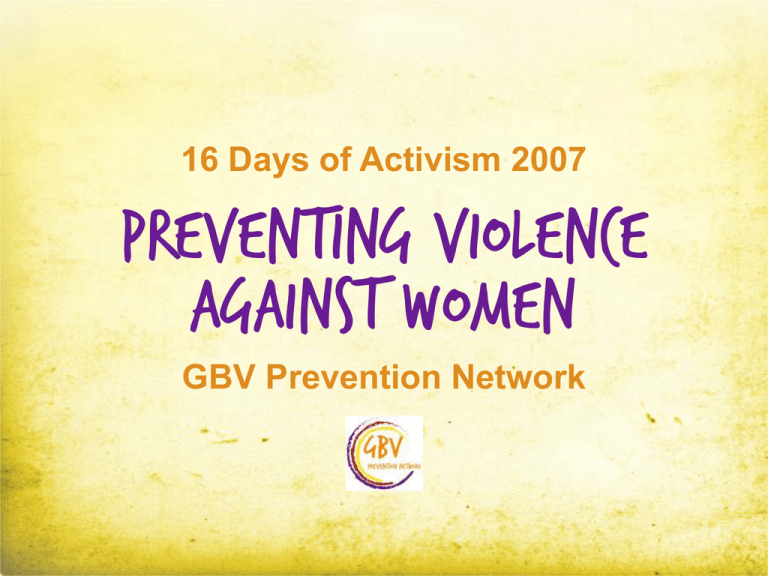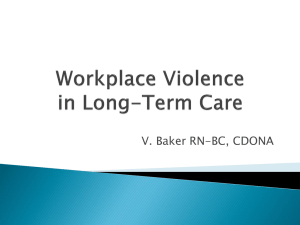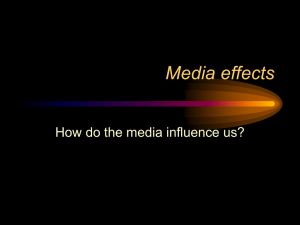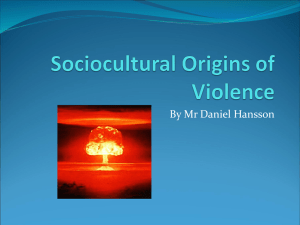
16 Days of Activism 2007
Preventing Violence
Against Women
GBV Prevention Network
Facts
At least 1 in every 3 women around the world has
been beaten, abused, or coerced into sex during
her lifetime.1
Many women in Africa report experiencing forced sex.
30 percent in Kenya 2
24 percent in Uganda 3
25 percent in Zimbabwe 4
30 percent in South Africa 5
Background
Today violence against women is recognized as
a critical public health and fundamental
human rights issue
Activism from women’s organizations over
the last decades broke the silence on
violence against women.
What is Violence Against Women?
The term gender-based violence is commonly used to refer
to violence against women. This is violence which occurs
as a result of women’s subordinate status in society .
Violence against women is any act of gender-based violence
that results in, or is likely to result in, physical, sexual, or
mental harm or suffering to women, including threats of
such acts, coercion or arbitrary deprivation of liberty,
whether occurring in the public or private life.
(UN Declaration on the Elimination of Violence Against Women,1993)
Types of violence
Violence against women includes but is not limited to the following:
Physical violence
Hitting, slapping, punching, kicking, burning, cutting, or
otherwise harming the body
Sexual violence
Rape (in or out of marriage), assault, attempted rape,
forced prostitution, incest, coercion,
female genital mutilation, sexual harassment,
inappropriate/unwanted touching
Types of violence
Economic Violence
Overwork, denial of ownership of property, withholding or
taking earnings, denial of inheritance, withholding
education, unequal pay, not being allowed to work,
deprivation of access to basic needs such as food and
shelter.
Emotional violence
Verbal abuse, threats, insults, control, constant
criticism, intimidation, humiliation.
Cause of Violence Against Women
The cause of violence against women is
women’s low status in the home and
community.
Using power and control over women
is violence.
Women are considered less valuable than and
subordinate to men. Men are seen as having
power and legitimacy to control women.
Contributing Factors
Although alcohol and poverty are often
identified as causes, they are triggers or
contributing factors to violence.
They are not the
root cause of violence!
Violence throughout Women’s Life Cycle
Women are vulnerable to different types of violence within their life cycle:
Infancy:
When they are born, girl babies in some parts of Africa are
vulnerable to general neglect such as less healthcare and
nutrition than male children of the same age
Childhood:
Young girls are faced with sexual abuse, malnutrition,
FGM, overwork
Violence throughout Women’s Life Cycle
Adolescence:
Forced prostitution, coercion, transactional sex,
trafficking, forced early marriage, rape and other
forms of sexual abuse
Reproductive age:
Intimate partner violence, sexual assault by non-partner
or intimate partner, sexual harassment, sex trafficking
Elderly:
Elder/widow abuse, loss of land and
inheritance, rape
Consequences of VAW for women
Physical Consequences
Physical injuries - fractures, concussions, cuts, broken
bones, gunshot wounds
Poor health- chronic pain, gastrointestinal disorders
Permanent disability
Death due to homicide or suicide
Sexual consequences
Unwanted pregnancies
Sexually transmitted infections including HIV
Miscarriages, low birth weight babies 6
Consequences of VAW for women
Emotional Consequences
Depression
Stress
Panic disorders
Low self esteem
Drug and/or alcohol abuse
Economic Consequences
Loss of economic productivity
Less hours worked due to injury and illness
Costs of treatment reduces family and community incomes
7
Consequences of VAW for men
Unhappy relationship with partner
Emotional distance and mistrust from the children
Health problems such as sexually transmitted
infections including HIV/AIDS
Emotional problems, such as depression,
hopelessness, lack of satisfaction
Strain on the finances of the family due to
expenditure on treatment, loss of productive hours
Imprisonment
Community resources used solving violence cases with
authorities i.e. police, family or clan leaders 8
Consequences of VAW for children
Children live in fear all the time
Low self esteem
Problems in school e.g. poor performance
Violent behavior
Sensitive
Withdrawal from activities
Sleeping problems 9
Consequences of VAW for communities
Loss of productive labor force due to poor
health, disability, death
Increased crime
Lack of harmony within the community
Women excluded from leadership and
political processes
Alcohol and drug abuse
Stress on health and social services
Underdevelopment of community
Why should we prevent VAW?
Women’s Human Rights
The right to life
The right to equality
The right to liberty and security of person
The right to equal protection under the law
The right to be free from all forms of discrimination
The right not to be subjected to
torture, or other cruel, inhuman or
degrading treatment or punishment.
10
Why should we prevent VAW?
Health reasons
Reduce serious consequences to
women’s physical and mental
health
Reduce the transmission of STDs
including HIV/AIDS
Why should we prevent VAW?
Economic reasons
Reduce the burden on healthcare systems
Reduce the strain on family resources and
national resources as well
Foster economic growth by having more productive
hours, victims of violence have less hours spent in
production
What can you do to prevent
violence against women?
As a woman, what can you do?
Talk to family members about the benefits of a healthy
relationship
Support other women experiencing violence
Foster in boys and young men a respect
for girls and young women
Treat your boy and girl children equally
Be open, honest and direct with young people when
they ask about sex and relationships
Seek support when you are experiencing violence
As a man, what can you do?
Commit to non-violence in your own relationships
Talk to other men about the benefits of a healthy relationship
Plan and enjoy fun things to do together with
your family
Share family responsibilities with your partner
Respect your partner as you wish to be respected
Treat your boy and girl children equally
Foster in boys and young men a respect for girls and young women
As a young person, what can you do?
Commit to non-violence in all your relationships
Talk to your friends about healthy relationships
Offer support to friends experiencing violence
Respect each other boys and girls - as equals
Respect that no means no
Learn how to solve problems by talking not fighting
Join or create youth groups to talk about issues
important to you
As a community member, what can you do?
Believe women when they tell you they are experiencing violence
Speak out when you know violence is happening
Model healthy relationships in your family and work place
Encourage others to share family responsibilities
Preach in churches and mosques about how happy
families are non-violent families
Advocate for zero-tolerance policies for sexual violence in your schools
As police, health workers or other professionals, be
supportive and encouraging to women who report violence
16 Days of Activism
International campaign against violence against women
Unites organizations and individuals across the world
Takes place from
November 25th to December 10th each year.
This 16-day period includes the following important days:
November 25th : International Day against Violence
against Women
December 1st : World AIDS Day
December 10th : International Human Rights Day
We’re committed to preventing
violence against women!
...what about you?
Speak out.
Reach out.
Stand out.
End notes
1.Heise L., Ellsberg M. and Gottenmoeller M. (1999). “Ending Violence Against Women,” Population Reports,
Series L, No. 11, Baltimore, Johns Hopkins University School of Public Health, Populations Information Program
2.Johnston T. (2002). “Gender Series: The Sexual Abuse of Kenyan Women and Girls,A Briefing Book,” Population
Communication Africa, Nairobi, Kenya
3.Koenig M., Lutalo T., Zhao F., Nalugoda F., Kiwanuka N., Wabwire-Mangen F., Kigozi G. et al. (2004). “Coercive
Sex in Rural Uganda: Prevalence and Associated Risk Factors,” Science & Medicine
4.The Word Health Organization (2002),” Gender and HIV/AIDS,’’ Geneva, Switzerland
5. Wood K., Maforah F., and Jewkes R. (1996). “Sex, Violence and Constructions of Love Among Xhosa
Adolescents: Putting Violence on the Sexuality Education Agenda,” CERSA-Women's Health Medical Research
Council, Tygerberg, South Africa
6. Ellsberg M, Heise L. (2005) “Researching Violence Against Women: A Practical Guide for Researchers and
Activists.” Washington DC, United States: World Health Organization, PATH
7. Ellsberg M, Heise L. (2005) “Researching Violence Against Women: A Practical Guide for Researchers and
Activists.” Washington DC, United States: World Health Organization, PATH
8. Michau L, Naker D. (2003) “Rethinking Domestic Violence: A Training Process for Community Activists,”
Kampala, Uganda: Raising Voices.
9. Michau L, Naker D. (2003) “Rethinking Domestic Violence: A Training Process for Community Activists,”
Kampala, Uganda: Raising Voices.
10. The Universal Declaration of Human Rights (UDHR), The International Covenant on Civil and Political Rights
(ICCPR)










